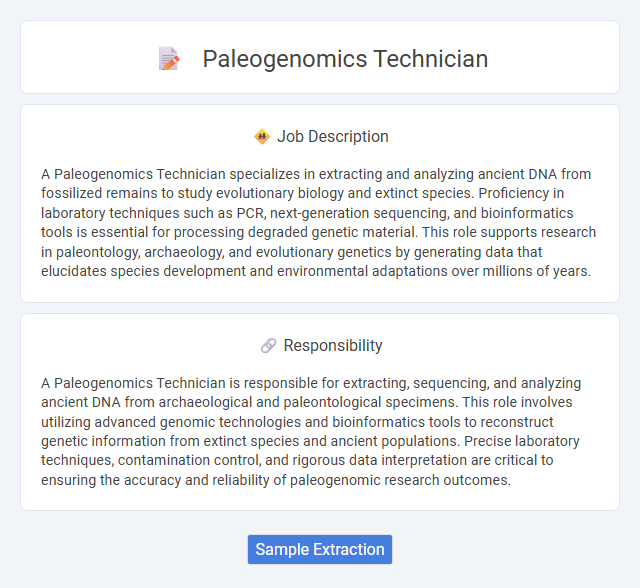
A Paleogenomics Technician specializes in extracting and analyzing ancient DNA from fossilized remains to study evolutionary biology and extinct species. Proficiency in laboratory techniques such as PCR, next-generation sequencing, and bioinformatics tools is essential for processing degraded genetic material. This role supports research in paleontology, archaeology, and evolutionary genetics by generating data that elucidates species development and environmental adaptations over millions of years.
Individuals with strong analytical skills and a passion for ancient DNA research are likely to thrive as Paleogenomics Technicians. Those who enjoy meticulous lab work and have a background in molecular biology or genetics may find this role particularly suitable. Candidates uncomfortable with detailed laboratory procedures or lacking patience for complex data analysis might face challenges in this position.
Qualification
A Paleogenomics Technician requires expertise in molecular biology techniques, including DNA extraction, PCR amplification, and next-generation sequencing, specializing in ancient DNA samples. Proficiency in bioinformatics tools for genomic data analysis and contamination control protocols is essential to ensure data integrity. A background in genetics, archaeology, or related fields, complemented by hands-on experience with high-throughput sequencing technologies, enhances job performance and research accuracy.
Responsibility
A Paleogenomics Technician is responsible for extracting, sequencing, and analyzing ancient DNA from archaeological and paleontological specimens. This role involves utilizing advanced genomic technologies and bioinformatics tools to reconstruct genetic information from extinct species and ancient populations. Precise laboratory techniques, contamination control, and rigorous data interpretation are critical to ensuring the accuracy and reliability of paleogenomic research outcomes.
Benefit
Paleogenomics Technicians likely benefit from engaging in cutting-edge research that combines genetics and archaeology, offering opportunities to contribute to groundbreaking discoveries about ancient DNA. They probably gain hands-on experience with advanced laboratory techniques and bioinformatics tools, enhancing their technical expertise and career prospects. This role may also provide a collaborative environment with multidisciplinary teams, fostering professional growth and networking possibilities.
Challenge
Paleogenomics Technicians likely face the challenge of working with highly degraded and ancient DNA samples, which may complicate sequencing and analysis processes. The complexity of extracting viable genetic material from fossils or sediment samples could pose significant technical obstacles. Handling contamination risks and ensuring data accuracy might require meticulous laboratory protocols and advanced bioinformatics skills.
Career Advancement
A Paleogenomics Technician plays a crucial role in analyzing ancient DNA to uncover evolutionary histories, using advanced sequencing technologies and bioinformatics tools. Mastery of laboratory techniques and data interpretation fosters opportunities for promotion to senior research scientist or project lead positions within genomic research institutions. Continuous skill development in paleogenomics and computational biology enhances career growth and access to interdisciplinary collaborative projects.
Key Terms
Sample Extraction
Paleogenomics Technicians specialize in the precise extraction of ancient DNA samples from fossils, bones, and sediment, ensuring minimal contamination and maximum preservation of genetic material. They utilize advanced techniques such as sterile sampling environments, enzymatic digestion, and ultraclean reagent protocols to retrieve high-quality DNA fragments for sequencing analysis. Mastery in sample extraction is critical for reconstructing evolutionary histories and understanding genetic diversity in extinct species.
 kuljobs.com
kuljobs.com